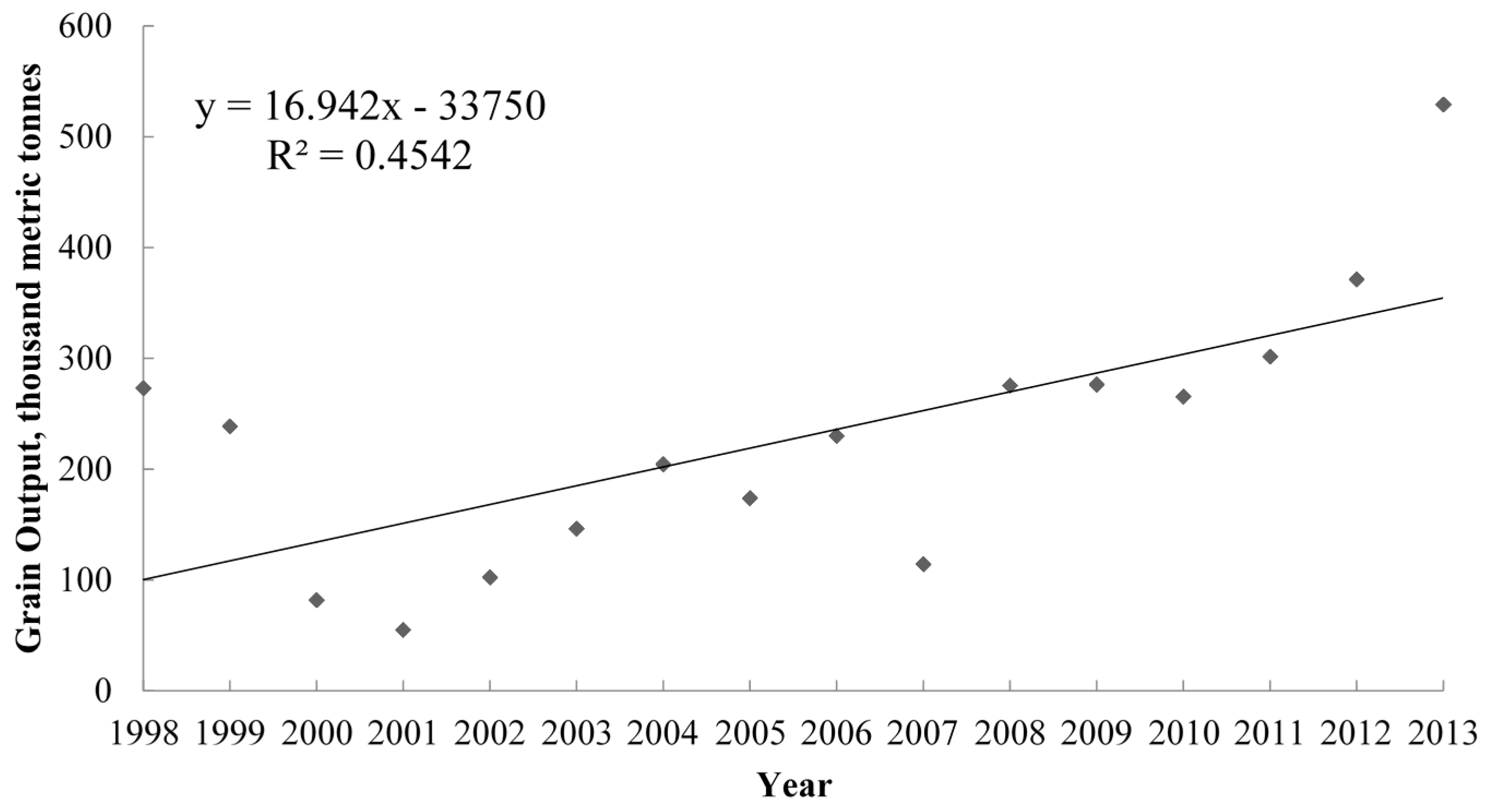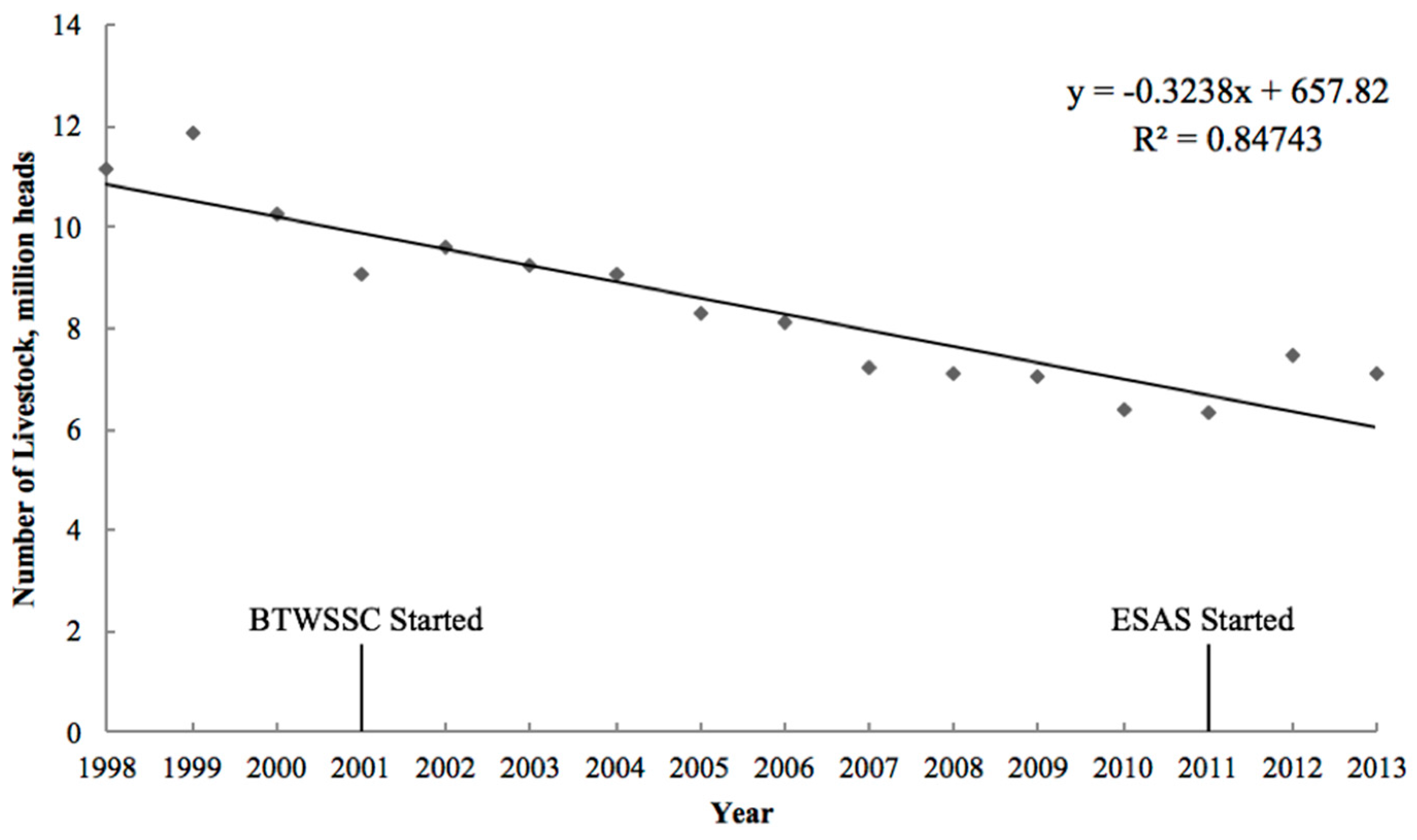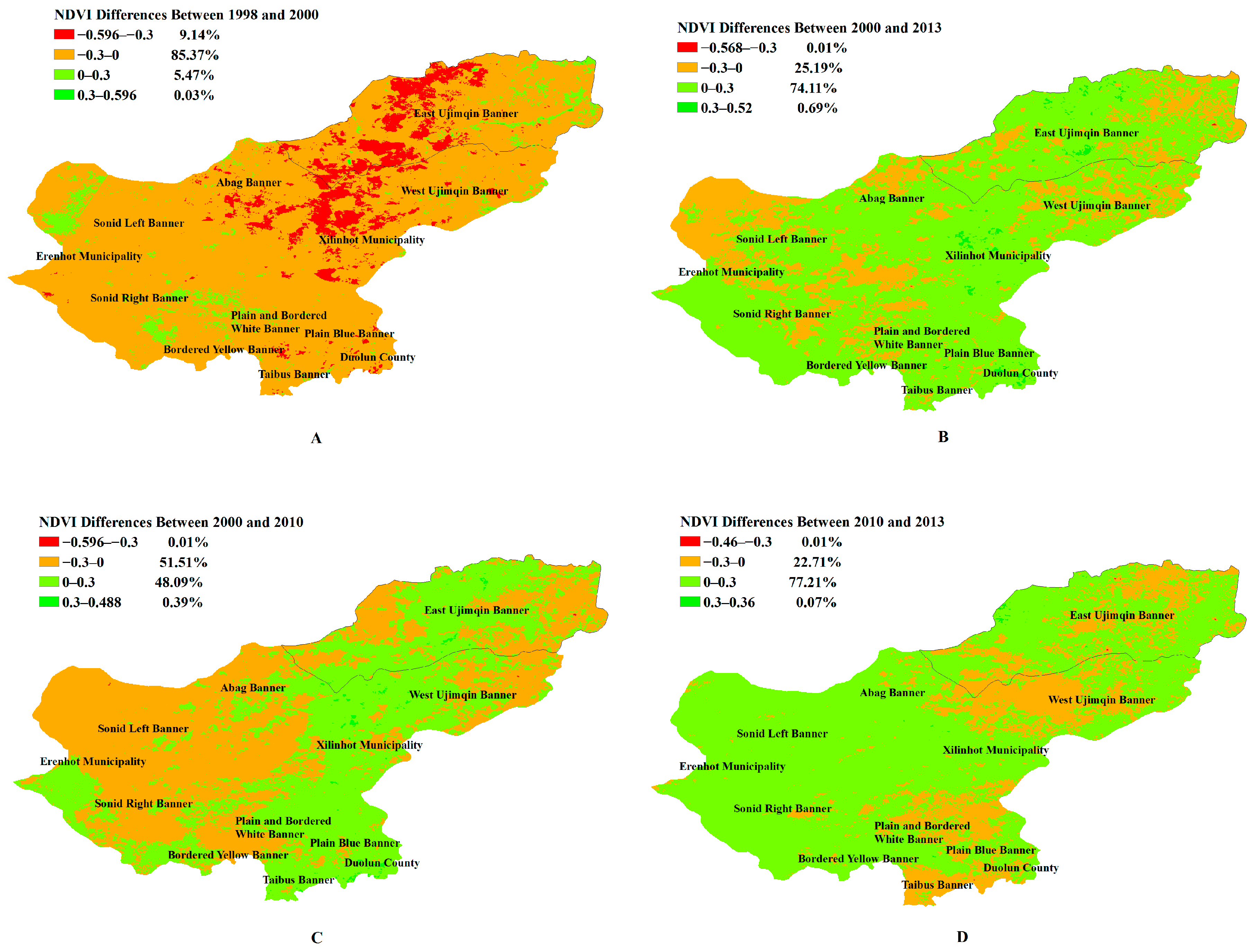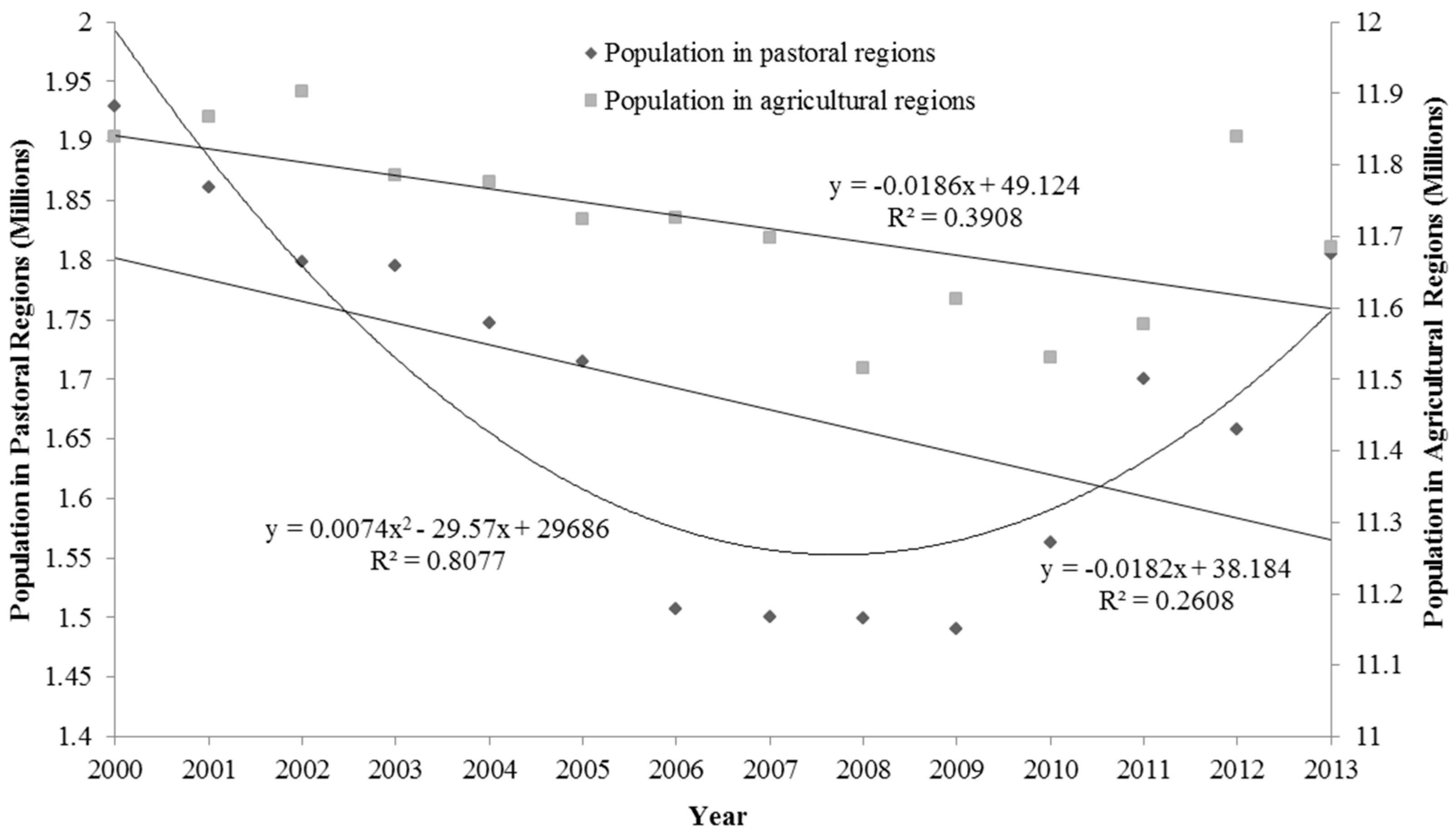Effects of Major Grassland Conservation Programs Implemented in Inner Mongolia since 2000 on Vegetation Restoration and Natural and Anthropogenic Disturbances to Their Success
Abstract
:1. Introduction
2. Materials and Methods
2.1. Study Area
2.2. Specification of Fixed Effects Models
2.3. Data Acquisition and Processing
2.4. Data Analysis
3. Results
3.1. Spatial and Temporal Variations of Vegetation Coverage in Xilingol League from 1998 to 2013
3.2. Contributors to NDVI Value Changes in Xilingol League from 1998 to 2013
4. Discussion
4.1. Effects of Major Grassland Conservation Programs on Vegetation Restoration
4.2. Natural and Anthropogenic Disturbances to the Success of Grassland Conservation Programs
5. Conclusions
Acknowledgments
Author Contributions
Conflicts of Interest
References
- US Department of Agriculture, Soil Conservation Service. National Range Handbook; US Department of Agriculture: Washington, DC, USA, 1976.
- Branson, F.A.; Gifford, G.F.; Renard, K.G.; Hadley, R.F. Rangeland Hydrology. Society for Range Management Range Science Series No. 1; Kendall: Dubuque, IA, USA, 1981. [Google Scholar]
- Allen-Diaz, B.; Chapin, F.S.; Diaz, S.; Howden, M.; Puigdefábregas, J.; Stafford Smith, M. Rangelands in a changing climate: Impacts, adaptations, and mitigation. In Climate Change 1995: Impacts, Adaptations and Mitigation of Climate Change: Scientific-Technical Analyses; Cambridge University Press: Cambridge, UK, 1995; pp. 131–158. [Google Scholar]
- Havstad, K.M.; Peters, D.P.; Skaggs, R.; Brown, J.; Bestelmeyer, B.; Fredrickson, E.; Herrick, J.; Wright, J. Ecological services to and from rangelands of the United States. Ecol. Econ. 2007, 64, 261–268. [Google Scholar] [CrossRef]
- Twidwell, D.; Allred, B.W.; Fuhlendorf, S.D. National-scale assessment of ecological content in the world’s largest land management framework. Ecosphere 2013, 4, 1–27. [Google Scholar] [CrossRef]
- Miller, M.E.; Belote, R.T.; Bowker, M.A.; Garman, S.L. Alternative states of a semiarid grassland ecosystem: Implications for ecosystem services. Ecosphere 2011, 2, 1–18. [Google Scholar] [CrossRef]
- Kéfi, S.; Rietkerk, M.; Alados, C.L.; Pueyo, Y.; Papanastasis, V.P.; ElAich, A.; De Ruiter, P.C. Spatial vegetation patterns and imminent desertification in Mediterranean arid ecosystems. Nature 2007, 449, 213–217. [Google Scholar] [CrossRef] [PubMed]
- Milton, S.J.; du Plessis, M.A.; Siegfried, W.R. A conceptual model of arid rangeland degradation. Bioscience 1994, 44, 70–76. [Google Scholar] [CrossRef]
- Daliakopoulos, I.N.; Tsanis, I.K. Climate-induced catastrophic shifts in pastoralism systems managed under the maximum sustainable yield model. Oper. Res. 2014, 14, 177–188. [Google Scholar] [CrossRef]
- Porensky, L.M.; Mueller, K.E.; Augustine, D.J.; Derner, J.D. Thresholds and gradients in a semi-arid grassland: Long-term grazing treatments induce slow, continuous and reversible vegetation change. J. Appl. Ecol. 2016, 53, 1013–1022. [Google Scholar] [CrossRef]
- Van de Koppel, J.; Rietkerk, M.; Weissing, F.J. Catastrophic vegetation shifts and soil degradation in terrestrial grazing systems. Trends Ecol. Evol. 1997, 12, 352–356. [Google Scholar] [CrossRef]
- Ellis, J. Grasslands and Grassland Sciences in Northern China; National Academies: Washington, DC, USA, 1992. [Google Scholar]
- Waldron, S.; Brown, C.; Longworth, J. Grassland degradation and livelihoods in China’s western pastoral region: A framework for understanding and refining China’s recent policy responses. China Agric. Econ. Rev. 2010, 2, 298–320. [Google Scholar] [CrossRef]
- Han, J.; Zhang, Y.; Wang, C.; Bai, W.; Wang, Y.; Han, G.; Li, L. Rangeland degradation and restoration management in China. Rangel. J. 2008, 30, 233–239. [Google Scholar] [CrossRef]
- Li, S.; Verburg, P.H.; Lv, S.; Wu, J.; Li, X. Spatial analysis of the driving factors of grassland degradation under conditions of climate change and intensive use in Inner Mongolia, China. Reg. Environ. Chang. 2011, 12, 461–474. [Google Scholar] [CrossRef]
- Chen, H.; He, L.; Tang, H.; Zhao, M.; Shao, L. A Two-Step Strategy for Developing Cultivated Pastures in China that Offer the Advantages of Ecosystem Services. Sustainability 2016, 8, 392. [Google Scholar] [CrossRef]
- Akiyama, T.; Kawamura, K. Grassland degradation in China: Methods of monitoring, management and restoration. Grassl. Sci. 2007, 53, 1–17. [Google Scholar] [CrossRef]
- Jiang, G.; Han, X.; Wu, J. Restoration and management of the Inner Mongolia grassland require a sustainable strategy. Ambio 2006, 35, 269. [Google Scholar] [CrossRef] [PubMed]
- Sheng, G.; Harazono, Y.; Oikawa, T.; Zhao, H.; Zong, Y.; Xue, L. Grassland desertification by grazing and the resulting micrometeorological changes in Inner Mongolia. Agric. For. Meteorol. 2000, 102, 125–137. [Google Scholar]
- Yang, Y.; Fang, J.; Ma, W.; Smith, P.; Mohammat, A.; Wang, S.; Wei, W. Soil carbon stock and its changes in northern China’s grasslands from 1980s to 2000s. Glob. Chang. Biol. 2010, 16, 3036–3047. [Google Scholar] [CrossRef]
- Aronson, J.; Floret, C.; Floc’h, E.; Ovalle, C.; Pontanier, R. Restoration and rehabilitation of degraded ecosystems in arid and semi-arid lands. I. A View from the South. Restor. Ecol. 1993, 1, 8–17. [Google Scholar] [CrossRef]
- Li, W.; Li, Y. Rangeland Degradation Control in China: A Policy Review. In The End of Desertification? Springer: Berlin/Heidelberg, Germany, 2016; pp. 491–511. [Google Scholar]
- Chen, J.; Tang, H. Effect of Grazing Exclusion on Vegatation Characteristics and Soil Organic Carbon of Leymus chinensis Grassland in Northern China. Sustainability 2016, 8, 56. [Google Scholar] [CrossRef]
- Zhang, X.; Niu, J.; Buyantuen, A.; Zhang, Q.; Dong, J.; Kang, S.; Zhang, J. Understanding Granssland Degrandation and Restoration from the Perspective of Ecosystem Services: A Case Study of the Xilin River Basin in Inner Monglia, China. Sustainability 2016, 8, 594. [Google Scholar] [CrossRef]
- Liu, A.; Xing, Q.; Su, R.; Wang, J.; Guo, G. Study on Effects of Grassland Bans and Rests in Xilingol League. Inner Mong. Prataculture 2003, 15, 1–4. (In Chinese) [Google Scholar]
- Shi, S.; Zou, X.; Zhang, C.; Su, G. Investigation of vegetation restoration in the area of Beijing and Tianjin sandstorm source control project. Sci. Soil Water Conserv. 2009, 7, 86–92. (In Chinese) [Google Scholar]
- Xing, Q.; Liu, A.; Liu, Y.; Gao, W. Study on Change of Rangeland Vegetation Using MODIS-NDVI in Xilingol Grassland. Acta Agrestia Sin. 2005, 13, 15–19. (In Chinese) [Google Scholar]
- Wang, L. Some thoughts on the performance and sustainability of retire livestock restore grassland projects. J. Inner Mong. Agric. Univ. 2009, 11, 116–118. (In Chinese) [Google Scholar]
- Wang, Y.; Qiao, Y. Problems in implementing retire livestock, restore grassland projects and counter measures. Agric. Econ. Probl. 2011, 2, 99–103. (In Chinese) [Google Scholar]
- Gu, Y.; Li, W. Research on the grazing ban policy’s effect to grassland quality: Analysis on the scale of herdersman households. Acta Sci. Nat. Univ. Pekinensis 2013, 49, 288–296. (In Chinese) [Google Scholar]
- McNaughton, S. Grazing as an optimization process: Grass-ungulate relationships in the Serengeti. Am. Nat. 1979, 113, 691–703. [Google Scholar] [CrossRef]
- Rui, X.; Shuia, Z.; YongFei, B. Impacts of grazing intensity and management regimes on aboveground primary productivity and compensatory growth of grassland ecosystems in Inner Mongolia. Biodivers. Sci. 2010, 18, 300–311. [Google Scholar] [CrossRef]
- DeAngelis, D.L.; Waterhouse, J.C. Equilibrium and nonequilibrium concepts in ecological models. Ecol. Monogr. 1987, 57, 1–21. [Google Scholar] [CrossRef]
- Pickup, G.; Bastin, G.N.; Chewings, V.H. Identifying trends in land degradation in non-equilibrium rangelands. J. Appl. Ecol. 1998, 35, 365–377. [Google Scholar] [CrossRef]
- Pickup, G. Estimating the effects of land degradation and rainfall variation on productivity in rangelands: An approach using remote sensing and models of grazing and herbage dynamics. J. Appl. Ecol. 1996, 33, 819–832. [Google Scholar] [CrossRef]
- Tongway, D.J.; Sparrow, A.D.; Friedel, A. Degradation and recovery processes in arid grazing lands of central Australia. Part 1: Soil and land resources. J. Arid Environ. 2003, 55, 301–326. [Google Scholar] [CrossRef]
- Carlson, T.N.; Ripley, D.A. On the relation between NDVI, fractional vegetation cover, and leaf area index. Remote Sens. Environ. 1997, 62, 241–252. [Google Scholar] [CrossRef]
- Karnieli, A.; Agam, N.; Pinker, R.T.; Anderson, M.; Imhoff, M.L.; Gutman, G.G.; Panov, N.; Goldberg, A. Use of NDVI and land surface temperature for drought assessment: Merits and limitations. J. Clim. 2010, 23, 618–633. [Google Scholar] [CrossRef]
- Gong, Z.; Kawamura, K.; Ishikawa, N.; Goto, M.; Wulan, T.; Alateng, D.; Yin, T.; Ito, Y. MODIS normalized difference vegetation index (NDVI) and vegetation phenology dynamics in the Inner Mongolia grassland. Solid Earth 2015, 6, 1185–1194. [Google Scholar] [CrossRef]
- Tong, C.; Wu, J.; Yong, S.; Yang, J.; Yong, W. A landscape-scale assessment of steppe degradation in the Xilin River Basin, Inner Mongolia, China. J. Arid Environ. 2004, 59, 133–149. [Google Scholar] [CrossRef]
- Liu, S.; Yan, D.H.; Shi, X.L.; Wang, G.; Yuan, Z.; Yin, J. Grassland NDVI response to climate factors in different vegetation regionalizations in China. Commun. Comput. Inf. Sci. 2013, 399, 370–380. [Google Scholar]
- Verbeek, M. A Guide to Modern Econometrics; John Wiley & Sons: Hoboken, NJ, USA, 2008. [Google Scholar]
- Wang, X.; Han, J.; Dong, Y. Recent grassland policies in China: An overview. Outlook Agric. 2005, 34, 105–110. [Google Scholar] [CrossRef]
- Grassland Supervision and Management Bureau, Inner Mongolia Autonomous Region. Annual Monitoring Report on Ecological Effects of Grazing Withdrawal Project (2011). Hohhot, China, 2012. Available online: http://www.nmagri.gov.cn/zxq/bmdt/219606.shtml (accessed on 2 September 2016). (In Chinese) [Google Scholar]
- National Development and Reform Commission, The State Council, P.R.C. Beijing-Tianjin Wind/Sand Source Control Project Plan (2001–2010). Beijing, China, 2002. Available online: http://www.sdpc.gov.cn/fzgggz/ncjj/nczc/200804/t20080414_203913.html (accessed on 2 September 2016). (In Chinese) [Google Scholar]
- National Development and Reform Commission, The State Council, P.R.C. Beijing-Tianjin Wind/Sand Source Control Project Stage II Plan (2013–2022). Beijing, China, 2012. Available online: http://www.gov.cn/jrzg/2012-10/07/content_2238717.htm (accessed on 2 September 2016). (In Chinese) [Google Scholar]
- Miao, D.; Liu, Y. Annual National Grassland Monitoring Report (2012). Chin. Anim. Husb. 2013, 8, 14–29. (In Chinese) [Google Scholar]
- Department of Agriculture and Animal Husbandry, Inner Mongolia Autonomous Region. Implementatino Plan for Grassland Ecological Subsidy and Award System. Hohhot, China, 2011. Available online: http://www.nmgzfgb.gov.cn/information/nmgzb20/msg6770100299.html (accessed on 2 September 2016). (In Chinese) [Google Scholar]
- Wooldridge, J.M. Introductory Econometrics: A Modern Approach; Nelson Education: Toronto, ON, Canada, 2015. [Google Scholar]
- Chinese National Meteorological Information Center. Available online: http://data.cma.cn (accessed on 2 September 2016).
- Li, Y.; Li, W. China’s Rangeland Management Policy Debates: What Have We learned? Rangel. Ecol. Manag. 2015, 68, 305–314. [Google Scholar]
- Bartolome, J.W. Application of herbivore optimization theory to rangelands of the western United States. Ecol. Appl. 1993, 3, 27–29. [Google Scholar] [CrossRef] [PubMed]
- Gao, X.; Wang, M.; Filippo, G. Climate change over China in the 21st century as simulated by BCC_CSM1.1-RegCM4.0. Atmos. Ocean. Sci. Lett. 2013, 6, 381–386. [Google Scholar]
- Zhang, G.; Kang, Y.; Han, G.; Sakurai, K. Effect of climate change over the past half century on the distribution, extent and NPP of ecosystems of Inner Mongolia. Glob. Chang. Biol. 2011, 17, 377–389. [Google Scholar] [CrossRef]
- Neupert, R.F. Population, nomadic pastoralism and the environment in the mongolian plateau. Popul. Environ. 1999, 20, 413–441. [Google Scholar] [CrossRef]
- Sun, X.; Ao, R.; Erden, U. Study on human population migration in the pastoral region of Xilingol League. 2009. Available online: http://d.wanfangdata.com.cn/conference/7622213 (accessed on 2 September 2016). (In Chinese)
- Wang, X.; Chen, F.; Dong, Z. The relative role of climatic and human factors in desertification in semiarid China. Glob. Environ. Chang. 2006, 16, 48–57. [Google Scholar] [CrossRef]
- Friedel, M.H.; Sparrow, A.D.; Kinloch, J.E.; Tongway, D.J. Degradation and recovery processes in arid grazing lands of central Australia. Part 2: Vegetation. J. Arid Environ. 2003, 55, 327–348. [Google Scholar] [CrossRef]
- Asefa, D.T.; Oba, G.; Weladji, R.B.; Colman, J.E. An assessment of restoration of biodiversity in degraded high mountain grazing lands in northern Ethiopia. Land Degrad. Dev. 2003, 14, 25–38. [Google Scholar] [CrossRef]





| Variables | Definition | Unit | Mean | Standard Deviation |
|---|---|---|---|---|
| Mean of all cells’ NDVI values in county at year | na | 0.3838 | 0.1314 | |
| Annual precipitation of county at year | mm | 256.67 | 90.64 | |
| Human population of county at year divided by its land area | person km−2 | 11.56 | 16.39 | |
| Logarithmically transformed gross domestic production of county at year divided by its land area | thousand Yuan·km−2 | 4.651 | 1.304 | |
| Grain output of county at year divided by its land area | tonnes km−2 | 3.792 | 9.879 | |
| Dummy variable, 1-year delayed effect of the BTWSSC program on NDVI value of county at year | na | na | na | |
| Dummy variable, 2-year delayed effect of the BTWSSC program on NDVI value of county at year | na | na | na | |
| Dummy variable, 1-year delayed effect of the ESAS program on NDVI value of county at year | na | na | na | |
| Dummy variable, 2-year delayed effect of the ESAS program on NDVI value of county at year | na | na | na |
| Dependent Variable: | |||
|---|---|---|---|
| Independent Variables | Pastoral Counties | Non-Pastoral Counties | All Counties |
| 0.000593 *** | 0.000346 | 0.000496 *** | |
| (0.000098) | (0.000208) | (0.000105) | |
| 0.010828 * | −0.008827 | 0.011678 ** | |
| (0.004950) | (0.013012) | (0.003982) | |
| −0.028087 ** | 0.011959 | −0.025898 *** | |
| (0.008491) | (0.027944) | (0.007323) | |
| 0.001617 | 0.000004 | −0.000355 | |
| (0.005232) | (0.000193) | (0.000217) | |
| −0.015598 | −0.055948 | −0.021886 * | |
| (0.011848) | (0.050088) | (0.011235) | |
| 0.030130 | 0.008291 | 0.038136 ** | |
| (0.019851) | (0.037597) | (0.016597) | |
| 0.085061 *** | 0.095782 ** | 0.092436 *** | |
| (0.014685) | (0.022237) | (0.013894) | |
| 0.054234 *** | 0.037332 | 0.048633 *** | |
| (0.007897) | (0.023596) | (0.007053) | |
| constant | 0.237703 *** | 0.473286 | 0.185076 *** |
| (0.031152) | (0.324697) | (0.042854) | |
| Adjusted R2 | 0.576 | 0.398 | 0.540 |
| F | 811.25 | 5 | 127.285 |
| N | 126 | 42 | 168 |
© 2017 by the authors. Licensee MDPI, Basel, Switzerland. This article is an open access article distributed under the terms and conditions of the Creative Commons Attribution (CC BY) license ( http://creativecommons.org/licenses/by/4.0/).
Share and Cite
Shao, L.; Chen, H.; Zhang, C.; Huo, X. Effects of Major Grassland Conservation Programs Implemented in Inner Mongolia since 2000 on Vegetation Restoration and Natural and Anthropogenic Disturbances to Their Success. Sustainability 2017, 9, 466. https://doi.org/10.3390/su9030466
Shao L, Chen H, Zhang C, Huo X. Effects of Major Grassland Conservation Programs Implemented in Inner Mongolia since 2000 on Vegetation Restoration and Natural and Anthropogenic Disturbances to Their Success. Sustainability. 2017; 9(3):466. https://doi.org/10.3390/su9030466
Chicago/Turabian StyleShao, Liqun, Haibin Chen, Chen Zhang, and Xuexi Huo. 2017. "Effects of Major Grassland Conservation Programs Implemented in Inner Mongolia since 2000 on Vegetation Restoration and Natural and Anthropogenic Disturbances to Their Success" Sustainability 9, no. 3: 466. https://doi.org/10.3390/su9030466






